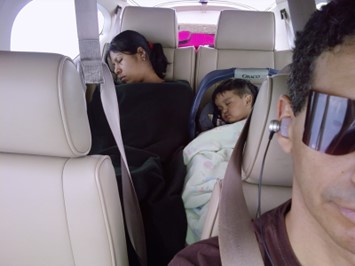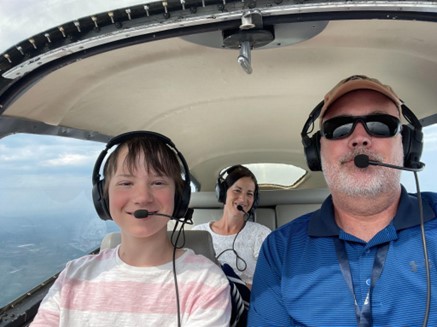Pilots join flying clubs for a variety of reasons—chief among them a desire to fly more. Being a member of a club gives pilots affordable access to aircraft that otherwise might be hard to come by. Pilots use club planes for fun, for business, for the occasional family trip, but if you’re looking to add a little more purpose to your aviation activities, consider public benefit flying.
Simply put, public benefit flying is flying to help others. Every day, volunteer pilots all across the U.S. donate their time, aircraft, hard-earned skills, and flight expenses to assist the health and well-being of others.
The Air Care Alliance, an umbrella group representing a nationwide league of volunteer pilot organizations, estimates that its members provide well over 40,000 free flights for humanitarian purposes each year. Those flights are operated by nearly 13,000 volunteer pilots nationwide that help patients access distant medical care, relocate endangered animals, deliver blood or precious cargo, or even support conservation efforts.
This type of flying provides a variety of benefits to our communities, but perhaps an even greater benefit to the pilots themselves as you’ll read below. There are many good reasons to get involved with volunteer flying. Here are a few.
An airplane must be flown, why not fly it for good?
Using your club aircraft for public benefit flights gives pilots a great excuse to actually fly it. There are only so many sightseeing flights one can make, and only so many $199.99 hamburgers that can be eaten before a pilot begins to wonder what’s next (and stops scheduling the aircraft as frequently). Public benefit flying offers a great reason to keep that plane in the air. There is a sense of “I’m doing something meaningful” that simply can’t be matched by boring holes in the sky.

New experiences; new destinations
Volunteer flights may take you to airports not normally on your radar; to new cities or states; or through airspace you might normally avoid. Flights for conservation support or disaster response bring a new level of planning and coordination—along with some atypical flight profiles. (When was the last time you flew turns around a point?) Whether you choose to fly patients, relocate endangered animals, or introduce youth to aviation, each public benefit flight you make is an opportunity to sharpen your skills and gain new experiences in aviation.

Improve the perception of general aviation
As pilots, we understand very well the vital importance of general aviation and small airports to our economy and community. We can point to economic impact reports, job creation, and gains for small businesses. But oftentimes, noise-averse airport neighbors or members of the general public are simply unaware of the immense value generated by GA. Getting involved with volunteer flying—and sharing your involvement with others—is a great way to humanize aviation and demonstrate its value to the greater society.
Change the life of someone in need doing what you love
Combining something you love to do with helping someone in need is one of the best ways to find purpose in your flying. The flights you provide can be lifesaving or life changing. What better use for your flying skills than to deliver health, hope, and humanity?

Get involved today
There are more than 60 public benefit flying organizations under the Air Care Alliance umbrella, representing a wide variety of worthy causes. Each would be delighted to have members of your flying club on their roster. If you’d like to explore more about volunteer flying, you can find plenty of information on the ACA website. (www.aircarealliance.org) There, you can complete one volunteer application and apply to as many public benefit flying organizations as you wish.
For further learning about the roles and responsibility of volunteer flying, ACA strongly recommends (and many groups require) taking the AOPA’s Air Safety Institute online course “Public Benefit Flying: Balancing Safety and Compassion”. The course delves into the details of volunteer flying and is available for Wings credit.
Volunteer Flying Organizations
In addition to some of the better-known volunteer organizations such as the various Angel Flights around the country or Pilots N Paws, below are a few other organizations that have public benefit flying opportunities that flying club members may be interested in.
Canine Companions
Since 1975, Canine Companions has been providing expertly trained service dogs free of charge. They breed, raise, and train their service dogs to be matched with adults or children with physical, cognitive or auditory disabilities, and veterans with a disability or with post-traumatic stress disorder (PTSD). The organization also provides trained facility dogs to professionals working in a health care, visitation, criminal justice or education settings, to help enhance their work with their clients.

Canine Companions puppies begin their journey in Northern California and need transport to volunteer puppy raisers all over the country, who raise and train them for their first 18 months. The organization has an Aviation Partners program, using volunteer pilots to transport the puppies, which it is looking to expand.
Their greatest need is for pilots to transport puppies from near their Santa Rosa, CA campus to their regional training facilities around the country or to cities that have a large concentration of volunteers. They are developing a program where pilots will help transport puppies from hubs around the country to surrounding areas. To learn more, visit canine.org/AviationPartners. Pilots must have a minimum of 200 flight hours of experience and must be willing to travel a minimum of 500 nautical miles.
LightHawk – From monitoring land trusts to transporting endangered species, LightHawk flights have contributed to the success of conservation projects across the country for more than 40 years. Pilots are required to have a minimum of 1,000 hours PIC because some of the flying may require low level flights, maneuvering to view specific locations, or flying a more challenging profile than simply flying point to point, like many other public benefit flights. Because LightHawk flies a variety of missions, aircraft can range from single engine pistons with one to four seats, to turboprops and jets for wildlife transport.
Patient AirLift Services (PALS) – Patient AirLift Services is a Long Island, NY-based nonprofit similar to Angel Flight that arranges free flights for medical patients requiring medical diagnosis, treatment or follow-up who cannot afford or are unable to fly commercially. They also provide flights for family members of patients to ensure they have support when they are away from home for long periods. PALS assists military personnel and their families with free flights to aid in the recovery and rehabilitation processes for our wounded veterans. In addition, PALS has a history of supporting humanitarian efforts in the event of natural or man-made disasters.
Single-engine piston pilots are required to have a minimum of 350 hours total time, 50 hours PIC in the make and model aircraft being used for the mission. Multi-engine or turbine pilots must have 500 hours total time, 400 hours PIC, and 50 hours in make and model. All pilots must have an IFR rating and flown at least 50 hours in the previous 12 months.
Veterans Airlift Command – Veterans Airlift Command provides free, private air transportation to injured combat veterans for medical or other compassionate purposes through a national network of volunteer aircraft owners and pilots. There are no minimum hours listed on its web site, but pilots must be IFR rated, and the organization prefers multi-engine or high-performance single-engine aircraft, as flights are typically more than 250 miles.